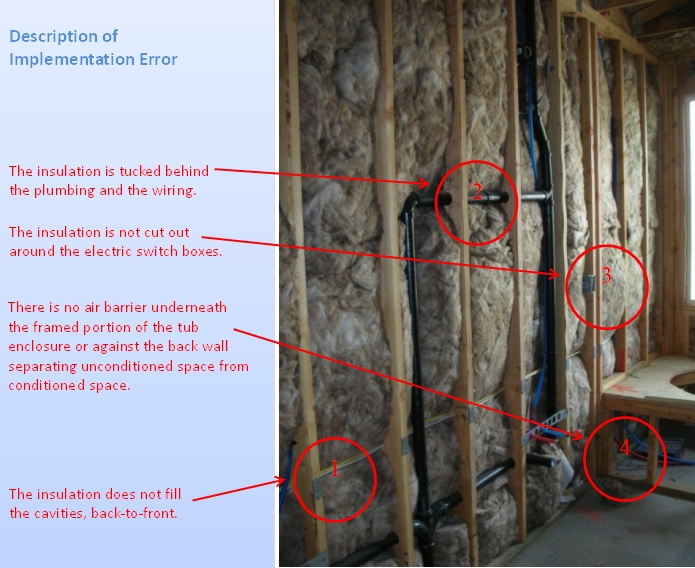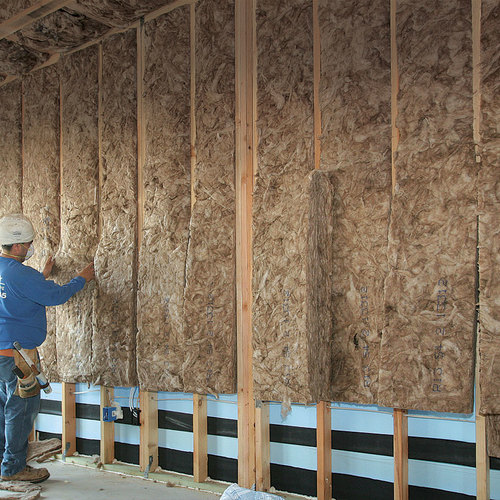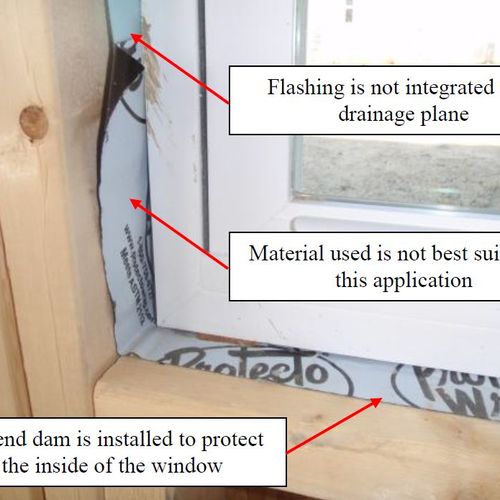Last week we published this photo as part of our “What’s Wrong With This Picture?” series. The photo shows a substandard fiberglass insulation job that was representative of an entire residential subdivision that hoped to qualify for Energy Star. Examples like this show that quality control by HERS raters is a weak link in the Energy Star program.
To comply with Version 3 of the Energy Star [no-glossary]Homes[/no-glossary] specification, a home must meet the requirements of the Thermal Enclosure System Checklist. Moreover, Version 3 specifications require cavity insulation to be installed to meet the Grade I installation standard developed by RESNET. According to the Grade I standard, insulation must be installed without gaps or flaws, filling the cavity from side to side and top to bottom, and with less than 2% of the insulated area showing signs of insulation compression. The standard required insulation to be split or fitted tightly around wiring, electrical boxes, and other services in the cavity.
Issue 1: The insulation does not fill the cavities, back-to-front
If you look at the lower left-hand corner of the photo, you can see that the batt doesn’t extend from right to left to fill the whole cavity.
Required corrections:
Achieving the Grade 1 standard with fiberglass batts is difficult. However, the standard is clear: insulation must fill the cavity completely, from side to side, from top to bottom, and from front to back.
MORE INFORMATION
Installing Fiberglass RightThe Energy Star Homes Program Raises the Bar with Version 3
Issue 2: The insulation is tucked behind pipes and wiring
No attempt was made to split the insulation around obstructions.
Required corrections:
The insulation must be split or cut so that it fits tightly around pipes, wiring and other services in the cavity.
Issue 3: The insulation is not cut out around the electrical boxes
These installers were clearly in a hurry.
Required corrections:
The insulation must be cut so that it fits tightly around and behind electrical boxes, without any gaps.
Issue 4: There is no air barrier behind the tub
Before this tub platform was framed, someone should have installed a durable air barrier on the interior side of the insulation.
Required corrections:
Walls behind showers and tubs, once correctly insulated, must be backed with an air barrier — for example, Thermoply — to prevent insulation from sagging and to create a continuous air barrier. All seams, gaps and holes in the air barrier must be sealed.
Weekly Newsletter
Get building science and energy efficiency advice, plus special offers, in your inbox.
















17 Comments
Two corrections about ENERGY STAR...
Great photo puzzler, Rob!
Those are indeed problems with this home that should be corrected, but, although the early Version 3 guidelines required all insulation to be installed to Grade I quality, they backed off of that requirement for assemblies with continuous insulation. A wall with foamboard on the outside, for example, can still qualify with a Grade II installation.
The other correction has to do with sheathing behind the bathtub. Unfortunately, that's not required in IECC climate zones 1-3. I talked with Sam Rashkin about that in the past, and he wasn't convinced there's any need to do it in warmer climates. I disagree, at least here in my part of CZ 3. We get ~3000 heating degree days per year and do more heating than cooling.
I have said this before but I
I have said this before but I have NEVER seen insulation installed that bad. I am either lucky or others are less so. Does anyone ever check a subs work prior to hiring them? If one piece was placed that bad in front of me that would be the last piece.
This is very common
AJ,
The difference may be your location. Based on the people who comment on the GBA site, there seems to be a northeast bias. Or at least more people from colder areas of the US and Canada. And in colder areas people appear to be much more aware of the importance of proper installation of insulation.
I live in SC where installation of insulation is mediocre at best. I posted some photos recently of mineral wool batt insulation in my brother's shop not too long ago.
https://www.greenbuildingadvisor.com/community/forum/energy-efficiency-and-durability/22755/installation-mineral-wool-insulation-shop
I even talked to the contractor about a Grade I batt installation and he didn't know what it was. He does now. He now reads GBA frequently.
The insulation guys came back and fixed the most egregious errors.
Allison Bailes works in GA and he said in one of his posts that he's only seen 2 Grade I installations. It is a common problem and something that has to be fixed if we are to upgrade the efficiency of our buildings.
These articles are very useful in educating people.
Lucy, yes the articles are
Lucy, yes the articles are good. All nationwide materials corporations should have voluntary certification programs for crews.
Certainteed has been certifying roofers for years now. I too though love freedom. IPAs being served at 5... Life is grand isn't it!
2x Grade I...with a caveat
Lucy, you're right that I said Grade I is very rare among the houses I've inspected but the qualifier is that it's rare for batt insulation to get Grade I. As you mentioned, I think I've seen only 2 that have gotten there with batts. Sprayed or blown products get to Grade I regularly, however.
Allison, that pic above is
Allison, that pic above is grade horrendous or worse. Not sure the number...
Response to aj
The sentiment is correct, aj, but the only thing worse than Grade III in the RESNET protocol is uninsulated. A HERS rater entering the Grade here would have to choose Grade III.
Allison correction
I meant to say only 2 Grade I batt insulation when I referred to your evaluations of insulation in your blog. Sorry about that.
AJ, forgive me but I do not know what IPAs are.
Another observation
If the builder was going for an Energy Star Home rating, they must have thought the insulation was pretty good or they wouldn't have asked the inspector to come over and evaluate it.
I just think that speaks to the degree of ignorance about how to install batt insulation. I wonder if it was from a home in the South or at least not in the Northeast. Could someone tell us where this photo was taken - what area of the country?
Meeting the Grade
It sounds like ENERGY STAR is trying to eliminate batt insulation without continuous insulation sheathing by requiring grade I. I agree that it is very difficult to get any installers to meet grade I, at least in the south where I work. I have done certifications for multifamily buildings with batt insulation where I have gone in an pulled out over 50% of the batts, multiple times, until the installers got it right. After redoing about 10 or 20 units the usually figure it out, but if any new crew member is put on, the rework starts all over again. I try to get my clients to use blown in batts or cellulose, but it always comes down to first cost and their insulation installers always assure them they can meet grade I and they never get the word down to the field installers who just do what they have always done. Someday it will get better.
Seems like a top notch
Seems like a top notch insulation company should have all the types of insulation and air sealing sprays. Spray seal, batt the standard on center areas and wet spray the other areas. In house certify. Only pay for grade 1 inspected completions.
Insulation job
Where's the vapor barrier???
IPA
IPA is India Pale Ale. Not Indian. The distinction is kind of important because it was made FOR India, not IN India. Originally a specialty bottled ale made for shipment to British colonial officers in the tropics, brewed stronger and with more hop than a standard pale ale to withstand the long sea voyage without losing its flavor. Truly an excellent beverage to enjoy while perusing construction nerd websites. IPA and GBA, jolly good, what!
IPA is Indian pale ale, one
IPA is India (edit, thanks James) pale ale, one of my favorite beverages.
Ignorant is to me as bad a word choice as the N word.
We sure are all different aren't we.
Carl, sounds like a business opportunity to open a GRADE 1 INSULATION COMPANY for all you south of the border.
Bad installation - worse QA
Yes, this is a bad insulation job, and yes, it's common, even in Energy Star homes. Too bad that the raters/inspectors aren't as informed as all of you, and that they don't take the time to make sure everything is done right. Of course, this would not happen if the folks who are supposed to do QA on the raters/inspectors are not doing their jobs! If the QA system worked, these poor jobs would be rare rather than common.
More than meets the eye
Not to justify the application in any way but, judging from the way the batts are installed behind the pipes and wires without getting torn or jumbled up, it appears this must be a 2 x 6 wall minumim, or a party wall of some type. Considering the set back of the wires and pipes from the face of the studs, there is no way a 3.5" batt was "pulled" behind these obstructions. If in fact this is a 2 x 6 thermal wall, then insulating it with less than cavity depth batts is an even greater mystery.
One more point I haven't seen made yet
Not a pro insulator, but I've always been under the impression that the paper side of the insulation goes towards the heated side. Being that I see no paper, I assume it's facing the wrong side......Unless there's no paper altogether, also something I haven't seen yet.
Log in or create an account to post a comment.
Sign up Log in